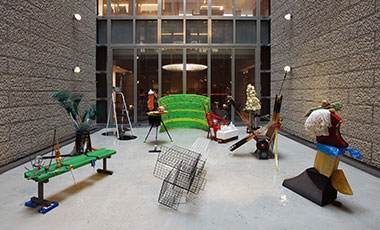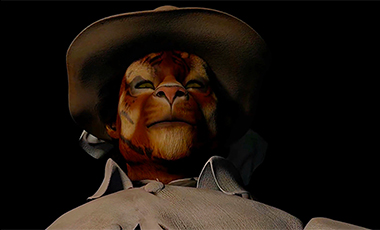 Installation view of Ha Chong-Hyun’s solo exhibition at Almine Rech Gallery in London. Courtesy the artist and Almine Rech Gallery.
Installation view of Ha Chong-Hyun’s solo exhibition at Almine Rech Gallery in London. Courtesy the artist and Almine Rech Gallery. All kinds of historical rediscoveries accompany the insatiable global creep of contemporary art as capital flows and narratives are written and rewritten. Central to the machinations of the ‘rediscovery’ of artists is that what passes as found again often never strayed in the first place. In actuality, artists are frequently blindsided by contemporary art’s institutions, institutions historically as white, sexist and parochial – not to mention fickle – as most others, but perhaps more singularly Euro-American given what passes for canonical modern art’s founding mytho-geography. In significant ways these factors are structural and changing, yet serve to remind us that critical reflection on exactly what it is we talk about when we talk about contemporary art – what, how and for whom? – remains as urgent as ever.
Being rediscovered can have the effect of levelling those small, quotidian labours that comprise most artists’ practices, but also comes, of course, with tremendous rewards: scholarship, shows and sales, not to mention storage, care and conservation of work. The irony, then, of Ha Chong-Hyun’s show at Almine Rech London is that although your average-person-in-a-West-London-Street is unlikely to be familiar with his name, even perhaps your average avowed art lover, he passes as art royalty in his native South Korea. (It’s hardly necessary for me to regale a specialist Korean readership with Chong-Hyun’s considerable contribution to Korean artistic culture – suffice it to say, however, that he, alongside a loosely affiliated number of Korean artists, known as ‘Dansaekhwa', who came to prominence in the early 1970s, is a recent rediscovery of Western collectors).
After decades of exhibitions in regional Korean museums, and participation in international biennales, Chong-Hyun’s show at Almine Rech London, which opened as a month-long show of paintings closed at the Paris gallery, follows solo presentations at Blum & Poe, New York and Los Angeles (New York was his first solo show in North America), Kukje Gallery, Seoul and Tina Kim Gallery, New York. At the 2015 Venice Biennale the curator Yongwoo Lee the director of Shanghai Himalaya Museum, curated a comprehensive survey of Dansaekhwa at the Palazzo Contarini-Polignac. Amid this interest, Joan Kee published her landmark study Contemporary Korean Art: Dansaekhwa and the Urgency of Method (Minnesota Press, 2013). Dansaekhwa is a fascinating case study of the complex abutments of private patronage, scholarship and the marketplace. ‘That work by artists such as Park Seobo or Ha Chong-Hyun has now been defined as Tansaekwha,’ Kee wrote in frieze magazine two years ago, ‘implies a shift in the promotion and reception of contemporary Korean art – as though the movement has become a form of branding tool.’ 1)
1) Joan Kee, ‘Skin & Surface’, frieze no.169 (March 2015)
 Ha Chong-Hyun, Conjunction 15-161, Oil (2015), Oil on hemp cloth, 130 × 162 cm. Courtesy the artist and Almine Rech Gallery
Ha Chong-Hyun, Conjunction 15-161, Oil (2015), Oil on hemp cloth, 130 × 162 cm. Courtesy the artist and Almine Rech Gallery Ha Chong-Hyun’s eponymously-titled exhibition at Almine Rech’s curiously frictionless London Mayfair space – opposite Larry Gagosian’s second London space, concurrently showing Picasso curated by his biographer Sir John Richardson – speaks to this. Yet, it’s doubtful we’d even be seeing this work if it was left to the capital’s museum institutions. (Gagosian’s financial clout enables him to mount Picasso shows that most museum directors can only dream of; it remains to be seen whether the same will apply to Chong-Hyun.)
Unlike in Paris, predominated, aside from Untitled 72-C of 1972, with work from the past couple of years, the London exhibition features painting or paintings from every decade since the early 1970s when Chong-Hyun began his celebrated ongoing ‘Conjunction’ series. As with Paris, aside from Untitled 72-007 of 1972, indices of barbed wire laid on canvas, all works in London belong to this series, from Conjunction 85-002 (1985) to the triptych Conjunction 16-42 (A+B+C) (2016).
An early work of Chong-Hyun's of particular note is Work 74-A (1974), which was produced by covering a wooden board with white paint then impressing wooden slats wrapped in brown paper upon it. Paint seeped through the slats, producing an image, which was finished by leaning the entire assemblage against a studio wall. Seeped paint trickled down the seams. In fact, ‘Conjunction’ refers to the occurrence of two or more events in a specific time and space and speaks of the situational, in this instance the meeting of paint and the support, and various contingent factors – a thrilling assertion of materiality minimising the artist’s hand.
Soon after, Chong-Hyun developed the technique of pushing old paint into the back of hemp fabric to extrude a facial ground that could receive usually repetitive marks with tools such as brooms or palette knives. The translation of force into organically configured pictorial space fascinated him. (Fecal analogies have been with Chong-Hyun’s painterly surfaces, but the bristling extrusions of, for instance, Conjunction 14-138 (2014) are more like squeezed pores and produce in me the ‘head orgasms’ of ASMR stimuli.) Hemp was useful on a number of accounts: it resembled, but departed from, the Euro-American modernist grid and had an optical quality that could productively be misconstrued as painting – a vacillation between object and image; Further, hemp, a monotonous dun brown ground,a ccentuated the phenomenological effects of a limited monochrome palette. In an extraordinary painting such as Conjunction 15-156 (2015), the wide tripartite streaks of white finish before the canvas edge in broiling heaps of hardened oil. It’s not only an exquisitely refined index of the painter’s physicality and powerfully divergent directional forces, but a beautiful image. Was the absence of interpretative text about process at Almine Rech a conscious decision to foreground image, I wonder?
 Installation view of Ha Chong-Hyun’s solo exhibition at Almine Rech Gallery in London. Courtesy the artist and Almine Rech Gallery.
Installation view of Ha Chong-Hyun’s solo exhibition at Almine Rech Gallery in London. Courtesy the artist and Almine Rech Gallery. Of grammar, a conjunction is a word used to connect clauses or sentences, such as ‘and’, ‘but’, ‘if’. The emblematic artist of Dansaekhwa, Park Seo-Bo, commenting on his Ecriture series, has said that he doesn’t paint as much as ‘move the brush like a scholar paints an orchid or writes characters’. Viewed in relation to writing, we might see Chong-Hyun’s ‘Conjunction’ series as grammatical conditionals writ large. But Almine Rech’s purportedly ‘important’ selection is too limited. If only we could see a truly representative and more diverse selection. And then we might find a favourable situation to begin to appreciate Ha Chong-Hyun’s rich and complex visual language.

※ This article was originally published in Art in Culture magazine (July 2017) and reprinted under authority of a MOU between KAMS and Art in Culture.
Jonathan P. Watts / contemporary critic based in London
Jonathan P. Watts is a contemporary critic, editor, independent curator based in London. His articles have been published in frieze, Art Monthly, Artforum magazines. He has lectured at Royal College of Art, London.


